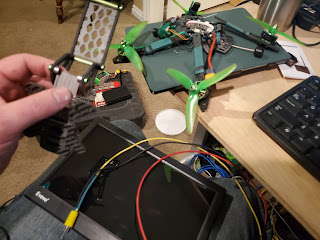I have a Dodge Ram. The rear back seat folds up to reveal some pockets, and I've had some emergency tools loosely thrown into one of these pockets.
These are awkwardly shaped, and not level. If my tools end up greasy or dirty, I'd rather not get the carpet soiled. Also, if I had a Craftsman set (one of those portable tool sets) that would have fit, I'd have just called it good. Commence over-engineering a new "toolbox".
I was told about "Kydex" from one of my buddies who loves leather work. Kydex is commonly used to make holster clips (attaching a holster to clothing) using a heat gun for forming. So, keeping that in mind, I ordered a 24"x36" sheet of Kydex.
Now, if I were to start this over, I'd do this a little differently. I'd go to the fabric store and by the cheapest, white-colored fabric (about a yard is all that is needed). I'd then lay the fabric into the pocket that I'm forming to, and draw lines every where there is overlap on the fabric. Then, I'd cut out the overlapped pieces, and I'd have my pattern to trace onto the Kydex sheet. However, I started before I ever even thought of that, and this is process I'm going to walk through.
First, I needed to get the shape of the base of that pocket. I used a sheet of paper and traced the corners to generate a base template.
With the base template, I could position that on the Kydex sheet and trace it on. I'm going to use a silver-colored sharpie for contrast. Placing this required measuring the height of the tool box to get it with the length of the sides as the distance away from the edges of the sheet.
The hardest part of all of this is that the compound curves are going to be difficult to form. I threw some lines coming as tangents from those curves for some saw lines, and measured the height away along those lines. Using those markings, I drew another line around the outside - my outside cut line.
What I was left with as a pattern that I could then cut out.
Those compound corners were going to bite me - I knew that, so I cut along those lines I'd used earlier to get the outside cut line in place. This would allow me to form the Kydex around those curves and corners.
Next up was to start forming the box. I lined the pocket with aluminum foil. This would protect the carpet in those pockets from heat as everything was formed.
Now, I broke out the heat gun, and heated along the original pattern lines until the sides could be bent up. I worked it a few times until I could drop it into the pocket and press the Kydex against the shape that it was being fit to. This was repeated numerous times until I was satisfied with the resulting shape.
With the shape set, it was a little flimsy - those sides were all loose-goosey. It was time to start "welding" it up. Mind you, I'm a terrible welder. But, hey, this is an experiment in futility, so, I jumped in. I did learn that my plastic welding is worse. But, it was adequate. I would weld some seams on the plastic about one inch in length, and slowly work my way along the entire seam. When I was satisfied, I'd use the heat gun and re-form the newly-joined sides back to the cavity.
This was a long process - a lot of repetition of plastic welding, heat gun forming, and inserting new pieces of Kydex to fill any gaps and holes.
The more I added, the stiffer this box became. There were a few times the welds snapped. I started even doing the "stack of dimes" with the plastic welder, and then I'd run over it dragging it to clean it up and get it strong enough. (Again, I'd only do about an inch at a time so that what I'd just welded didn't set until I had run the clean up drag stroke.) It was a lot of wash, rinse, repeat, until I had the base done. While I was there, I folded an area to hold a breaker bar, and "welded up" a bracket for the handle :
Then, being tired, I just dumped all of the tools back in.
I need to make some separators and organizers, layering the tools and giving each one a place to be. Then, I can call it good.



























